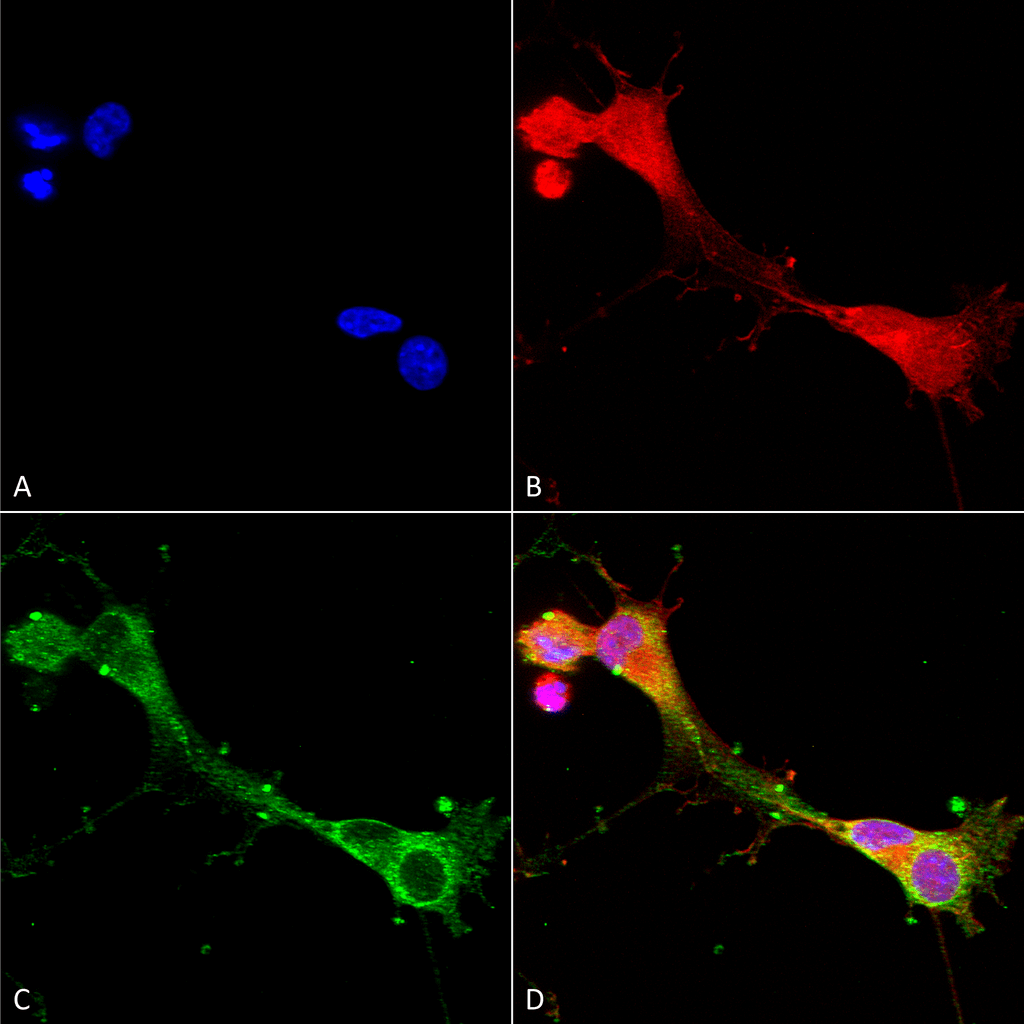Anti-ASIC1 Antibody (11573)
Anti-ASIC1 Antibody (11573)
Product No.: 11573
- -
- -
Clone S271-44 Target ASIC1 Formats AvailableView All Product Type Monoclonal Alternate Names ASIC1, Acid-sensing ion channel, Amiloride-sensitive cation channel 2, neuronal, Brain sodium channel 2, BNaC2 Isotype Mouse IgG1 Applications ICC , IF , IHC , WB |
Data
 Immunocytochemistry/Immunofluorescence analysis using Mouse Anti-ASIC1 Monoclonal Antibody, Clone S271-44 (11573). Tissue: Neuroblastoma cells (SH-SY5Y). Species: Human. Fixation: 4% PFA for 15 min. Primary Antibody: Mouse Anti-ASIC1 Monoclonal Antibody (11573) at 1:100 for overnight at 4°C with slow rocking. Secondary Antibody: AlexaFluor 488 at 1:1000 for 1 hour at RT. Counterstain: Phalloidin-iFluor 647 (red) F-Actin stain; Hoechst (blue) nuclear stain at 1:800, 1.6mM for 20 min at RT. (A) Hoechst (blue) nuclear stain. (B) Phalloidin-iFluor 647 (red) F-Actin stain. (C) ASIC1 Antibody (D) Composite.
Immunocytochemistry/Immunofluorescence analysis using Mouse Anti-ASIC1 Monoclonal Antibody, Clone S271-44 (11573). Tissue: Neuroblastoma cells (SH-SY5Y). Species: Human. Fixation: 4% PFA for 15 min. Primary Antibody: Mouse Anti-ASIC1 Monoclonal Antibody (11573) at 1:100 for overnight at 4°C with slow rocking. Secondary Antibody: AlexaFluor 488 at 1:1000 for 1 hour at RT. Counterstain: Phalloidin-iFluor 647 (red) F-Actin stain; Hoechst (blue) nuclear stain at 1:800, 1.6mM for 20 min at RT. (A) Hoechst (blue) nuclear stain. (B) Phalloidin-iFluor 647 (red) F-Actin stain. (C) ASIC1 Antibody (D) Composite. Western Blot analysis of Rat brain lysates showing detection of ASIC1 protein using Mouse Anti-ASIC1 Monoclonal Antibody, Clone S271-44 (11573). Primary Antibody: Mouse Anti-ASIC1 Monoclonal Antibody (11573) at 1:100, 1:250, 1:500, and 1:1000.
Western Blot analysis of Rat brain lysates showing detection of ASIC1 protein using Mouse Anti-ASIC1 Monoclonal Antibody, Clone S271-44 (11573). Primary Antibody: Mouse Anti-ASIC1 Monoclonal Antibody (11573) at 1:100, 1:250, 1:500, and 1:1000. Immunocytochemistry/Immunofluorescence analysis using Mouse Anti-ASIC1 Monoclonal Antibody, Clone S271-44 (11573). Tissue: Neuroblastoma cell line (SK-N-BE). Species: Human. Fixation: 4% Formaldehyde for 15 min at RT. Primary Antibody: Mouse Anti-ASIC1 Monoclonal Antibody (11573) at 1:100 for 60 min at RT. Secondary Antibody: Goat Anti-Mouse ATTO 488 at 1:100 for 60 min at RT. Counterstain: Phalloidin Texas Red F-Actin stain; DAPI (blue) nuclear stain at 1:1000, 1:5000 for 60min RT, 5min RT. Localization: Cell Membrane, Nucleus. Magnification: 60X. (A) DAPI (blue) nuclear stain. (B) Phalloidin Texas Red F-Actin stain. (C) ASIC1 Antibody. (D) Composite.
Immunocytochemistry/Immunofluorescence analysis using Mouse Anti-ASIC1 Monoclonal Antibody, Clone S271-44 (11573). Tissue: Neuroblastoma cell line (SK-N-BE). Species: Human. Fixation: 4% Formaldehyde for 15 min at RT. Primary Antibody: Mouse Anti-ASIC1 Monoclonal Antibody (11573) at 1:100 for 60 min at RT. Secondary Antibody: Goat Anti-Mouse ATTO 488 at 1:100 for 60 min at RT. Counterstain: Phalloidin Texas Red F-Actin stain; DAPI (blue) nuclear stain at 1:1000, 1:5000 for 60min RT, 5min RT. Localization: Cell Membrane, Nucleus. Magnification: 60X. (A) DAPI (blue) nuclear stain. (B) Phalloidin Texas Red F-Actin stain. (C) ASIC1 Antibody. (D) Composite. - -
- -
Antibody DetailsProduct DetailsReactivity Species Mouse ⋅ Rat Host Species Mouse Immunogen Fusion protein corresponding to aa 460-526 (cytoplasmic C-terminus) of mouse ASIC1 (accession no. Q6NXK8). Product Concentration Lot Specific Formulation PBS, pH 7.4; 50% glycerol, 0.09% sodium azide. State of Matter Liquid Product Preparation Purified by Protein G affinity chromatography Storage and Handling This antibody is stable for at least one (1) year at -20°C. Avoid repeated freeze-thaw cycles. Regulatory Status For in vitro investigational use only. Not for use in therapeutic or diagnostic procedures. Country of Origin USA Shipping Next Day 2-8°C Applications and Recommended Usage? Quality Tested by Leinco Immunoblotting: use at 1ug/mL. A band of ~60kDa is detected.
Positive control: Rat brain lysate. These are recommended concentrations. User should determine optimal concentrations for their application. Each investigator should determine their own optimal working dilution for specific applications. See directions on lot specific datasheets, as information may periodically change. DescriptionSpecificity This antibody recognizes mouse and rat ASIC1. It does not cross-react with ASIC2. Background Acid sensing (proton-gated) ion channel 1 (ASIC1) is a cation channel with high affinity for sodium which is gated by extracellular protons and inhibited by the diuretic amiloride. It is also permeable for Ca(2+), Li(+) and K(+) and mediates glutamate-independent Ca(2+) entry into neurons upon acidosis. This Ca(2+) overloading is toxic for cortical neurons and may be in part responsible for ischemic brain injury. ASIC1 functions as a postsynaptic proton receptor that influences intracellular Ca(2+) concentration and calmodulin- dependent protein kinase II phosphory- lation. Antigen DetailsFunction Proton-gated sodium channel; it is activated by a drop of the extracellular pH and then bPubMed:11988176, PubMed:12843249, PubMed:15369669, PubMed:15578512, PubMed:17060608, PubMed:17662962}. NCBI Gene Bank ID UniProt.org Research Area Ion Channels References & CitationsTechnical Protocols |
Formats Available
 Products are for research use only. Not for use in diagnostic or therapeutic procedures.
Products are for research use only. Not for use in diagnostic or therapeutic procedures.


